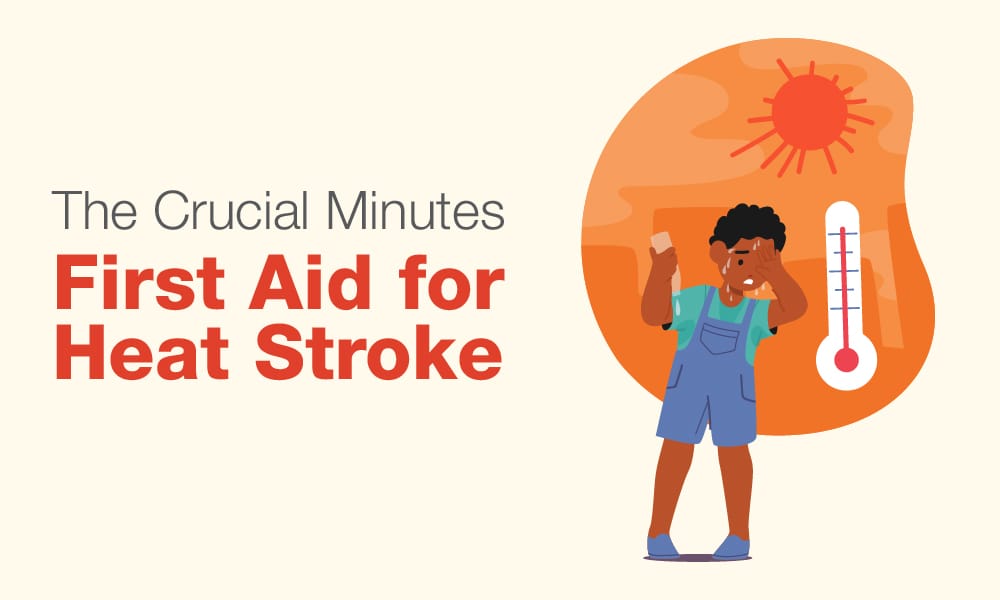
As temperatures rise across the globe, heat-related illnesses are becoming a major public health concern. Among them, heat stroke is the most serious, a potentially life-threatening emergency that demands immediate attention and a First Aid for Heat Stroke. According to the World Health Organisation, extreme heat causes thousands of preventable deaths each year, with the elderly, children, and those with chronic illnesses being most vulnerable. With climate change intensifying, heat stroke cases are on the rise, making awareness and proper heat stroke treatment more essential than ever.
This blog offers a detailed, research-backed, and practical guide on first aid for heat stroke, including early signs, emergency response, natural remedies, and first aid tips for adults and children. Whether you’re at home or outdoors, knowing what to do during a heat stroke emergency can save a life.
Understanding Heat Stroke: Why It’s a Medical Emergency
Heat stroke occurs when the body’s temperature regulation system fails due to prolonged exposure to high temperatures, often combined with dehydration. This causes the core body temperature to rise above 104°F (40°C), damaging internal organs and even leading to death if not treated immediately.
Some shocking global statistics:
A study published in The Lancet Planetary Health reported over 356,000 heat-related deaths globally in 2019.
In India, nearly 20,000 deaths were reported due to heat stroke between 1992 and 2015, according to the National Disaster Management Authority (NDMA).
Symptoms of Heat Stroke: Spot the Warning Signs Early
Identifying the early signs of heat stroke in adults is critical for initiating timely treatment. Symptoms can escalate quickly and may vary from person to person. Key symptoms of heat stroke include:
- High body temperature (above 104°F or 40°C)
- Hot, dry skin (lack of sweating despite heat)
- Rapid heartbeat
- Nausea and vomiting
- Dizziness and confusion
- Headache
- Fainting or unconsciousness
- Muscle cramps or weakness
Heat stroke in children may show slightly different symptoms, like:
- Irritability
- Lethargy
- Pale or red skin
- Rapid breathing
Recognising these signs early is the first step in offering effective heat stroke treatment.
Immediate Response to Heat Stroke Symptoms: What You Should Do
When someone shows signs of heat stroke, every second counts. Here’s an immediate response to heat stroke symptoms:
- Move the person to a shaded or cool place – indoors, under a fan, or beneath a tree.
- Call emergency services immediately – do not delay.
- Cool the person down quickly by:
- Removing excess clothing.
- Applying cold, wet clothes or compresses to the body.
- Using fans or air conditioning.
- Spraying the body with cool water.
- Place ice packs on high-heat areas: armpits, groin, neck, and back.
- Encourage the person to sip cool water if they are conscious and able to swallow.
Heat Stroke First Aid Guide for Summer Months
The summer months bring with them long hours of sun and soaring temperatures. Here’s a heat stroke first aid guide for the summer months:
1. Stay Hydrated
Dehydration is a leading cause of heat stroke. Drink plenty of water, even if you’re not thirsty.
2. Avoid Outdoor Activities During Peak Heat
Stay indoors between 11 a.m. and 4 p.m., when the sun is at its peak.
3. Wear Loose, Light-Coloured Clothing
This helps your body stay cool and minimises heat absorption.
4. Use Sunscreen and Hats
Protect your skin and head to prevent overheating.
5. Check on High-Risk Individuals
Children, elderly people, and those with medical conditions are more vulnerable. Monitor them regularly during summer.
These practices are your first line of defence and essential for heat stroke prevention.
First Aid for Heat Stroke in Children
Children are more prone to heat stroke due to their lower ability to regulate their body temperature. Here’s how to provide first aid during a heat stroke among children:
- Remove the child from the hot environment immediately.
- Undress them and apply cold compresses to the body.
- Use a fan or AC to bring down body temperature.
- Encourage sips of oral rehydration solution (ORS) or plain water.
- Never give medications like aspirin or ibuprofen without medical advice.
- Call a doctor or emergency helpline immediately.
Always prioritise heat stroke emergency care if the child shows severe symptoms like unconsciousness or seizures.

Natural Remedies for Heat Stroke Symptoms
Alongside standard first aid, several natural remedies for heat stroke symptoms can help support recovery:
1. Tender Coconut Water
Rich in electrolytes, it helps rehydrate and cool the body naturally.
2. Buttermilk
A traditional remedy that restores salt levels and prevents dehydration.
3. Lemon Juice with Salt and Sugar
Boosts energy and replenishes lost fluids.
4. Aloe Vera Juice
Known for its cooling properties, aloe vera soothes the system internally.
5. Mint Leaves and Cucumber
Both are cooling agents and can be consumed or applied topically for relief.
These home remedies can complement heat stroke treatment, but should never replace emergency medical care during a heat stroke emergency.
Best Ways to Treat Heat Stroke at Home
If caught in the early stages, heat stroke can often be managed at home, especially when the symptoms are mild and there is no loss of consciousness. Immediate action is critical to prevent the condition from escalating into a medical emergency.
Begin by moving the affected person to a cool, shaded, or air-conditioned environment. Have them lie down and rest, avoiding any further physical activity. The priority is to bring the body temperature down as quickly and safely as possible.
Encourage frequent sips of cool water, oral rehydration solution (ORS), or electrolyte-based sports drinks to replenish lost fluids and essential salts. Avoid caffeine or sugary drinks, as they can worsen dehydration.
A cool shower or sponge bath can help reduce body temperature effectively. You can also apply cold compresses or ice packs to key pulse points like the wrists, neck, armpits, and ankles — areas where blood vessels are close to the skin’s surface.
Ensure the person remains in a relaxed, cool space and continues to rest until all symptoms—such as dizziness, weakness, or headache—have fully resolved. However, if symptoms worsen or if there is no improvement within an hour, seek immediate medical attention, as heat stroke can progress rapidly and become life-threatening.

Preventing Heat Stroke: Proactive Care Saves Lives
While administering first aid for heat stroke is crucial during emergencies, prevention remains the most powerful tool in avoiding this potentially life-threatening condition. As temperatures soar, simple but proactive steps can significantly reduce the risk of heat stroke for yourself and those around you.
One of the most important preventive measures is to stay hydrated. Carry a water bottle with you at all times and drink water frequently, even if you don’t feel thirsty. Dehydration is a major contributor to heat-related illnesses, and avoiding caffeine and alcohol—both of which act as diuretics—can help maintain your body’s fluid balance during hot days.
Opt for light, easily digestible meals such as fruits, vegetables, and yoghurt-based dishes. Heavy meals increase internal body heat and slow down digestion, which can contribute to overheating.
If you’re heading outdoors, especially between 11 a.m. and 4 p.m., wear loose, light-coloured clothing that allows air circulation. Use an umbrella, hat, or scarf to shield yourself from direct sunlight. Applying sunscreen also helps protect your skin from sunburn, which can worsen the effects of heat exposure.
Indoors, ensure that your living and working spaces are properly ventilated. Use ceiling fans, exhaust fans, or air conditioners to maintain a cool environment. Closing blinds or curtains during peak sun hours can also help reduce indoor heat levels.
By consciously adopting these habits, you’re not only minimising the chances of a heat stroke emergency, but also promoting safer, more comfortable living in extreme weather conditions.
Conclusion: Be Prepared, Be Aware — Save a Life
Heat stroke is more than just a summer inconvenience — it’s a serious, life-threatening emergency. But with timely first aid for heat stroke, early symptom recognition, and preventive care, you can safeguard your health and the well-being of others. Whether you’re at home, at work, or travelling, understanding the best heat stroke treatments can help you act swiftly in a crisis.
Remember, knowledge saves lives. Stay hydrated, stay informed, and be the helping hand someone may need during a heat stroke emergency. Curious to know more about advanced heat stroke treatment methods or how to build a home first aid kit for summer? Keep exploring our blog and resources, because being prepared is the first step toward protection.





